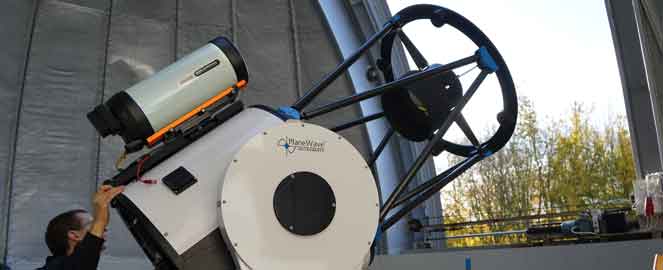NEW TELESCOPE AT THE OLE RØMER OBSERVATORY

Focus on the stars. A new telescope has landed at the Ole Rømer Observatory in Kongelunden, Aarhus.
The telescope is a mirror telescope with a mirror diameter of 70 cm, an upgrade from the old telescope with a 28 cm mirror diameter.
New City Icon
The mirror's diameter is crucial as a larger mirror gathers more light than a smaller one. It's like observing the night sky with a 70 cm eye, making this telescope the largest functioning one in Denmark.
"With the new telescope, visitors will have an even better experience," says Bent Lorenzen, director of the Science Museums, Aarhus University. "We hope it will increase interest in science among visitors in general and especially among school classes. Moreover, we believe it's fantastic that Aarhus has gained a newcomer and a new city icon, which can make its mark nationally as the largest functioning telescope in Denmark."
The new telescope weighs around 800 kg and had to be hoisted into the observatory through the dome using a crane. After the telescope was set up, they succeeded in achieving the 'First Light,' which signifies the first viewing of an astronomical object. Fortunately, the autumn weather was clear, allowing for a view of the Moon against the cloudless blue sky.
"It's the first time I've seen the Moon so closely. Despite the sunlight, you could see the moon craters in great detail. It was incredible," exclaimed astrophysicist Ole Eggers Bjælde from the Science Museums, who was among the first to witness the 'First Light' once the telescope was set up. "The mirror's size will allow us to see, for example, planets in far greater detail than we've been able to before. We'll be able to enjoy the sight of the bands across Jupiter or details in Saturn's rings. It also provides an opportunity to observe distant galaxies, star clusters, nebulae, and many other astronomical objects. We're excited to showcase the universe through the new telescope to our guests in January 2024."
Facts
Viewings with the new telescope will be open to visitors in January 2024. Until then, viewings will be conducted without the telescope. If the telescope is calibrated earlier, it may be included in the viewings in December 2023.
To accommodate visitors, the telescope will be set up with a smaller telescope mounted on top of the large one. The small telescope will be connected to a screen so that everyone can follow what is being observed. There are also plans to allow taking pictures of astronomical objects with a mobile phone.
The restoration of the Ole Rømer Observatory and the development of the Science Park in Aarhus are supported by:
Realdania: DKK 4.5 million
Aage and Johanne Louis-Hansens Fond: DKK 4 million
Salling Fondene: DKK 2 million
Nordea-fonden: DKK 2 million
Kongelunden, Aarhus Kommune: DKK 1 million
Aarhus University: DKK 3.5 million
Find press releases and press images for editorial coverage
7. november 2023
"Det er første gang at jeg har set Månen så tæt på." Teleskopet ankommer til Ole Rømer Observatoriet
26. september 2023
30. august 2023
Stjerner i Aarhus: Ole Rømer Observatoriet klar til genåbning. Billetsalget åbner 1. september 2023
24.maj 2023
16. marts 2023
2022
11. november 2022
24. august 2022
17 millioner til Sciencepark i Aarhus. Finansieringen er Ole Rømer Observatoriet er nu på plads
6. maj 2022
Ole Rømer-Observatoriet får støtte til renovering og nye aktiviteter. 8.5 millioner fra bidragydere